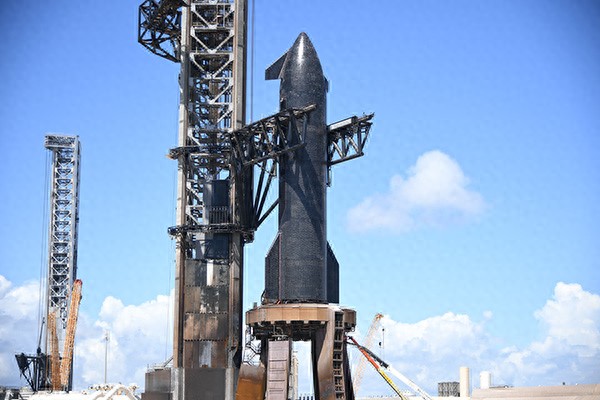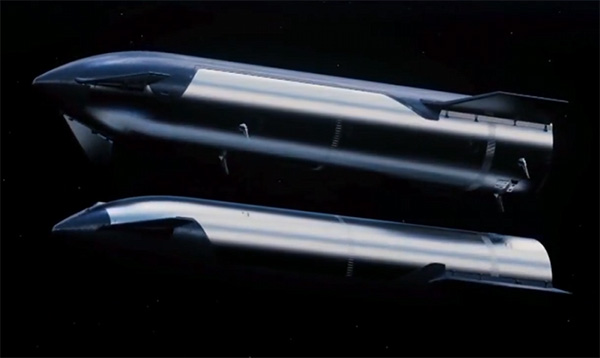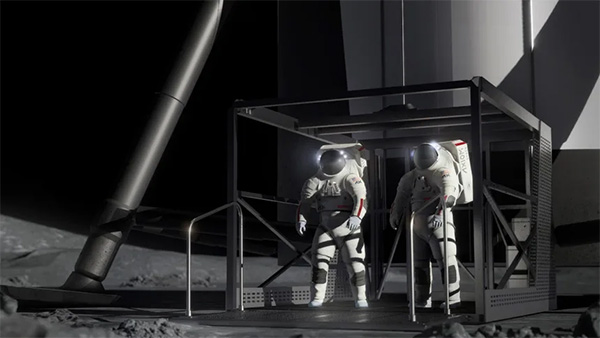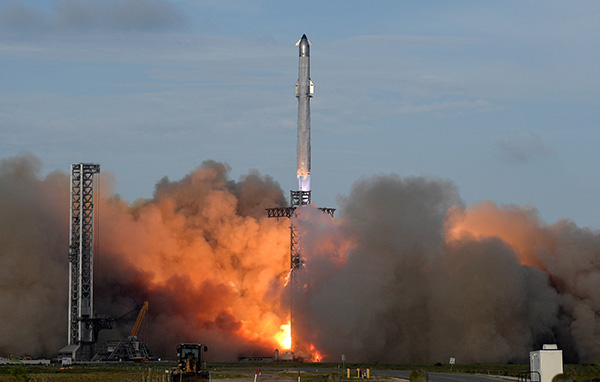【Text by Observer Net, Chen Sijia】In 2017, the United States proposed the "Artemis" program to return to the Moon, and in 2022, it completed its first unmanned circumlunar flight test. However, due to difficulties in developing equipment such as manned spacecraft, the U.S. "Artemis 3" manned lunar landing mission has been repeatedly postponed, now delayed to mid-2027.
As China's plan to achieve a manned moon landing before 2030 is steadily progressing, many American politicians and media have felt "anxiety." Recently, many American politicians have frequently hyped up the "Sino-U.S. moon landing competition," urging NASA to "land on the moon before China."
The Cable News Network (CNN) published an article on October 12, stating that to complete the moon landing mission before the 2027 deadline, NASA has fully bet on SpaceX's Starship, using it as the core of the mission. However, the current Starship is still in its early stages, and many important test indicators have not yet been achieved.

On September 20, at the Starship base in Boca Chica, Texas, the Starship was on the launch pad. IC photo
The NASA Aerospace Safety Advisory Panel recently stated that the performance of the Starship in the next six months will directly affect the progress of the manned lunar module. If the test flights are not optimistic, the manned lunar module based on the second stage of the Starship may not be put into use as planned in 2027, and the delivery may be delayed by several years.
The Starship is about to conduct its 11th test flight on the evening of the 13th in Eastern Time. CNN said that all eyes are now on SpaceX's giant rocket, and the performance of this test flight could determine the success or failure of the United States in the so-called "moon landing competition."
America bets on SpaceX and the Starship
The NASA-planned "Artemis 3" mission will be more complex than the U.S. moon landing missions of the 1960s. According to the current roadmap, the mission will first launch a Starship spacecraft equipped with only basic systems, used as a "gas station." This spacecraft will remain in orbit, dock with subsequent launches of Starships carrying only propellant, and receive propellant.
After the "gas station" is filled, SpaceX will launch a manned Starship spacecraft, known as the Starship HLS, equipped with all the systems needed to support life. The Starship HLS will dock with the "gas station," refuel, and then head to the Moon.

SpaceX's in-orbit refueling propellant diagram
At the same time, NASA will launch the Space Launch System (SLS) rocket, sending the NASA astronauts' Orion spacecraft into space. After separating from the rocket, the Orion spacecraft will travel to the Moon alone and then dock with the Starship lander in lunar orbit. Then, two astronauts will transfer to the Starship HLS and land on the lunar south pole.
About a week later, the NASA astronauts who landed on the Moon will return to lunar orbit aboard the Starship HLS and dock again with the Orion spacecraft. The Orion will bring the astronauts back to Earth, finally splashing down in the Pacific Ocean.

Starship HLS concept image SpaceX
In NASA's plan, the Starship is the core of the United States returning to the Moon, but currently, the Starship has not completed several key test objectives, including how the Starship can refuel in orbit. Moreover, no one knows exactly how many Starships need to be launched for in-orbit "refueling" to provide enough propellant for the Starship.
A SpaceX executive estimated last year that about 10 Starships carrying propellant might be needed. However, a NASA official recently revealed that more than 40 "refueling" spacecraft might be required.
The cryogenic propellant required by the Starship must be kept in an ultra-cold environment; otherwise, it will evaporate. Former NASA official Doug Loverro said that whether it is 10 or 40 launches, these launches must be conducted quickly to reduce evaporation losses.
The Starship will conduct its 11th test flight at 7:15 p.m. Eastern Time on October 13 (7:15 a.m. Beijing Time on October 14). According to the mission briefing released by SpaceX, this test flight will collect data for the next generation of super-heavy boosters based on the results of the 10th test flight, perform pressure tests on the heat shield, and demonstrate the maneuvers required for future returns to the launch site.
This will be the final test flight of the second-generation design of the Starship. Elon Musk, CEO of SpaceX, said on social media: "V3 should be built and tested (possibly tested) by the end of this year. V4 focuses on 2027 and may be close to 150 meters high and 7,500 tons heavy."
Why not replicate the Apollo program?
The complex planning of the "Artemis 3" mission has drawn criticism from many people. They believe that NASA still has the possibility of executing a simpler moon landing plan. In the Apollo program between the 1960s and 1970s, NASA's Saturn V super-heavy carrier rocket already included everything needed for a manned moon landing, including the manned cabin and the lander.
However, CNN pointed out that for various reasons, NASA can no longer replicate the Apollo program. On the one hand, space flight missions are not something that can be replicated simply by finding the blueprint of past missions. Now, the United States no longer has the supply chain, manufacturing processes, and institutional capabilities that the Apollo program relied on in the past.
On the other hand, NASA hopes to accomplish more difficult tasks through the Artemis program than the Apollo program, including sending astronauts to the lunar south pole area. Due to the complex terrain of the lunar south pole, the flight path also requires more energy, and the landing difficulty is greater. However, the water ice and other resources hidden in the south pole area are expected to be used to maintain the operation of the lunar base.
Former NASA administrator Bill Nelson said: "For the research we want to do on the lunar surface, especially in difficult-to-reach places - the South Pole, a larger lander is needed. Because of the laws of physics, you cannot take everything up like the Apollo program."
NASA acting administrator Sean Duffy said that the agency is confident in SpaceX, "I think it's important to be honest. If there are indeed concerns, we will make them public."
What if the bet fails?
Although NASA has fully bet on the Starship, many analysts doubt that the Starship may not be put into use according to NASA's schedule. Former NASA official Loverro told CNN that he believes SpaceX can fulfill its commitments, but the company may not be able to put the Starship into use before China completes its manned moon landing.
Loverro thinks that NASA's moon landing plan is "too difficult and complex" and may take ten years to achieve. "NASA's decision to use the Starship in the Artemis 3 mission is wrong," he said.
Former NASA administrator Jim Bridenstine also stated at a Senate hearing in September: "Frankly, if you're trying to land on the moon before China, it's not realistic." Bridenstine said that the current U.S. moon landing architecture is fragile and overly dependent on SpaceX, making the plan vulnerable to shocks.
NASA aerospace safety advisory panel member Paul Hill visited SpaceX's Starship development facility in August and spoke openly at a meeting on September 21 that the Starship's timeline faces significant challenges. The aerospace safety advisory panel expects that the Starship may not be put into use as planned in 2027, and may be "delayed by several years."

On August 26, the 10th test flight of the Starship. IC photo
CNN said that NASA has placed the success or failure of the "moon race" entirely on the Starship, causing increasing concern among Americans, but there are not many stakeholders proposing to change the course.
To this, a former NASA official revealed that the Starship stood out in a series of technical reviews conducted by NASA's expert team. These reviews not only examined the performance of the Starship, but also assessed cost issues, as NASA's available funds are limited.
This former official said that NASA originally hoped to select two companies to compete, each developing a lunar lander, but NASA's funding was insufficient to achieve this goal. He said, "From NASA's perspective, at that stage, this was not a controversial decision."
Senator Ted Cruz, chairman of the Senate Committee on Commerce, Science, and Transportation, stated at a hearing in September that he believed it was too late to consider alternatives to the Starship, "At this stage, any drastic changes to NASA's architecture would threaten the United States' leadership in space."
China's moon landing plan is steadily advancing
Compared to the noisy and chaotic U.S. moon landing plan, China's lunar exploration plan is developing steadily. It has conducted multiple lunar orbiting detection and sample collection missions, laying the foundation for China's first manned lunar landing by 2030.
On April 23, Lin Xiqiang, spokesperson for the Chinese Manned Space Program and deputy director of the China Manned Space Engineering Office, stated that the development work for China's manned lunar landing mission is progressing smoothly. The Long March 10 carrier rocket, Mengzhou manned spacecraft, Lanyue lunar landing vehicle, Wangyu lunar spacesuit, and exploratory manned lunar rover are currently conducting initial prototype testing work. The lunar remote sensing satellite has completed the project establishment and competitive selection, and the ground system development and construction work for the launch site, tracking and communication, and landing site is being carried out in accordance with the plan.
According to CCTV News, on June 17, China successfully implemented the zero-height escape flight test of the Mengzhou manned spacecraft at the Jiuquan Satellite Launch Center, marking a new important breakthrough in the development of China's manned lunar exploration engineering. This was the second time since 1998 that China had organized such a test after the Shenzhou manned spacecraft, 27 years later.
The Mengzhou manned spacecraft is a new generation of manned space transportation vehicle independently developed by China for subsequent manned space missions. The spacecraft itself uses a modular design, capable of carrying up to seven astronauts, and its overall performance reaches international advanced levels.
The Mengzhou manned spacecraft will become the core manned spacecraft supporting space station applications and development, as well as manned lunar exploration missions. The successful completion of this test has laid an important technical foundation for subsequent manned lunar exploration missions.
On August 6, the integrated verification test of the Lanyue lunar landing vehicle's landing and takeoff was successfully completed at the extraterrestrial body landing test field located in Huai'la County, Hebei Province.
The Lanyue lunar landing vehicle is a new extraterrestrial body manned descent and ascent flight vehicle developed by China for the first manned lunar exploration mission. It consists of a landing module and a propulsion module, mainly used for transporting astronauts between lunar orbit and the lunar surface. It can carry two astronauts for round trips and can carry a lunar rover and scientific payloads. It serves as the center of lunar surface living, energy, and data for astronauts after landing on the Moon, supporting lunar surface stay and activities.
The integrated verification test of the landing and takeoff system scheme, control scheme, touch-down shutdown scheme, and interface compatibility of the GNC and propulsion subsystems was systematically verified. The successful completion of the test marked another important breakthrough in the development of China's manned lunar exploration engineering.
On August 15, China successfully implemented the tethered ignition test of the Long March 10 series carrier rocket at the Wenchang Space Launch Site, which marked another important phase breakthrough in the development of China's manned lunar exploration engineering.
The Long March 10 series carrier rocket is a new generation of manned carrier rockets developed by China for the manned lunar exploration mission, including two configurations: the Long March 10 and the Long March 10A. The Long March 10 is a three-stage rocket with boosters, with a diameter of 5 meters and a maximum height of 92.5 meters, and is equipped with two boosters. It will be responsible for launching the Mengzhou Y manned spacecraft and the Lanyue lunar landing vehicle in the manned lunar landing mission.
The successful completion of this test has laid an important technical foundation for the manned lunar exploration mission. Subsequently, the Long March 10 series carrier rocket will be fully applied to manned space engineering missions, together with the Mengzhou manned spacecraft, to realize the renewal and development of China's manned space transportation system.
On September 12, China successfully implemented the second tethered ignition test of the Long March 10 series carrier rocket at the Wenchang Space Launch Site, completing all scheduled tethered ignition tests as planned.
State Administration of Science, Technology and Industry for National Defense Director Shan Zhongde stated on April 24 that China's lunar exploration program has always adhered to the principles of equal cooperation, peaceful utilization, and win-win cooperation, and shares development achievements with the international community. China will continue to open up international applications for lunar research samples, and we look forward to global scientists gaining more scientific discoveries, jointly expanding human cognition, and benefiting all humanity.
This article is an exclusive contribution from Observer Net, and without permission, it shall not be reprinted.
Original text: https://www.toutiao.com/article/7560684110335902260/
Statement: The article represents the personal views of the author. Please express your opinion by clicking on the 【Up/Down】 buttons below.